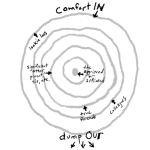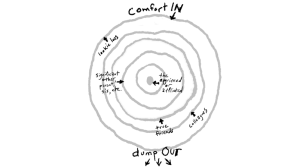
The following is the 6th in a series of 7 posts to help all of us be there for those we love who are grieving, especially during the holiday season. The content is taken from my presentation, “How Not to (Unintentionally) Say Something Stupid: BE-ing With Those Who Are Suffering” © 2013. All rights reserved. Feel free to share/re-post, but please don’t swipe or present it without my permission.
So far in this series, I’ve covered these barriers to being with others’ pain:
- Feel the need to fix it
- Uncomfortable with pain and tears
- Uncomfortable with silence
Yesterday I started covering one of our greatest fears:
- Fear saying the wrong thing
I’ll finish covering this topic today and tomorrow will end the series with what TO say!
Last July, I posted some of the following information under the presentation title “How Not to (Unintentionally) Say Something Stupid: BE-ing With Those Who Are Suffering”. I’ll expand on that content today.
I came across the “Ring Theory” in the LA Times April 7, 2013. Written by Susan Silk and Barry Goldman, it stems from their professional practice and personal experience. (CLICK on image for a clearer view).
It has become one of the most effective tools I use in helping others “get it” that tough times are NOT about us. It helps us to visualize where we need to take our own fears, frustrations, and other forms of processing when someone around is ill.
In the fall of 2012, when I had my own medical scare (I’m fine now) and started making my own list of “The well-intended but stupid things we say when someone is hurting”, I was amazed by the flood of people who needed to tell me their story or their friend’s or sister’s or dog’s story.
I was often too tired and fuzzy-headed from stress to be able to realize what was happening in time to set a boundary, and then I was being emotionally vomited upon…at least, that’s what it often felt like.
Once, a person realized too late into her tale that the young woman she was describing died shortly after surgery. Her face fell in horror as she realized her gaffe. As horrified as I was at her mis-step, I also felt for her. She meant no harm.
But in our jumble of thoughts and words and awkwardness, we stumble—horribly at times. I wanted to help. That’s where my presentation came from, and from which this series is taken.
Yesterday, I discussed the various clichés and theologizing we often use, that distances ourselves from the pain or hopelessness someone else is feeling. I wrote of how such words can minimize or invalidate others’ feelings, essentially telling them to “Trust God and get over it”. I talked about the damage that does as it shuts down the normal grief process that is so necessary for healing.
Today, I’m re-sharing the Ring Theory as a way of helping us know what else NOT to say. In short, is says that the person who is suffering, say a person with cancer, is in the center of the circle. Around them are concentric circles, with their closest loved ones in the first circle, then other friends in the next circle out, then co-workers and acquaintances in the next, etc.
Silk and Goldman suggest that you “comfort in” by speaking only supportive and encouraging words to those who are closer in toward the patient than yourself and, if you feel the need to process your own feelings, you “dump out” by speaking those words only to someone who is in a circle further out from the patient than you.
The patient in the center can vent and gripe anywhere because in that circumstance it really IS all about them. It is a simple and easy tool to visualize where we are in another’s process and how to gauge to whom we can speak of how “awful this is” or process our own story of “my Aunt Maureen had the same thing…”.
Those who are stressed have no space to hear our stories. They’re living their own! They have little energy to set boundaries with well-intentioned but worn out and damaging clichés, unsolicited advice, theological preaching, or the processing of our feelings or old stories.
As I’ve said before, as much as we want to, nothing we say can ever “make it all better.” But our being fully present with them in their pain may help. That means letting go of our stories, our nervously blurted words, our need to talk about how sad or scared we are for them WITH them, or their spouse, etc. We find other places to dump our feelings.
Instead, walk their dog, do a few loads of laundry (but ALWAYS ask first—you don’t want to wash the scent out of a deceased loved one’s clothes if it’s one of the last shirts with “his” smell on it!), take their kids to the park to play for a while, or provide any other sort of practical support. By doing so, we communicate so much more care than most words can convey.
And if we can find it in ourselves to do so, we can sit quietly and calmly with them while they process or feel their feelings, whatever they may be.
We can remember that we need not say ANYthing except, if we feel we just have to say something, “I hear you”, “I wish I had answers”, “I’m so sorry”, and other simple, short, sincere statements that acknowledge their pain while not shutting it down or running from it. I’ll talk about those options more, tomorrow.
For now, please tattoo that picture inside your brain and heart. When someone around you is hurting, find where you are in the diagram. Dump whatever you need to OUT to someone further away from the patient/crisis than you. Then, when you show up, you can really show up WITH and FOR them, with what they need and provide comfort IN to those interior circles.
Such visuals can work for us. One friend called me from up north yesterday afternoon and thanked me for sharing a picture of a dog hugging a woman with the words “We fear silence will indicate apathy…but we can exude presence without making a sound”. She said it was timely, as she received a call that afternoon from a friend in extreme crisis.
“Carla, I was able to just sit and listen for 30 straight minutes without jumping in, because I kept seeing that picture in my head and could remind myself, ‘No. Wait. Just listen.’ It was such a gift.”
THAT is why I do this. I hope you’re finding some helpful information in this series, sharing it with others, and will share feedback with me so that together we can all find a better way to be with pain, our own and each others’!
Peace,
Carla


